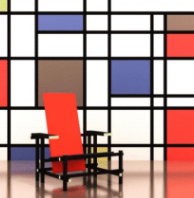THE BAUHAUS MOVEMENT
The Bauhaus movement began in 1919 when Walter Gropius founded a school with a vision of bridging the gap between art and industry . He combined crafts and fine arts to do that . Before Bauhaus movement, fine arts such as architecture and design were seen in higher esteem than craftsmanship (i.e., painting, woodworking, etc.), but Gropius showed that all crafts, includi ng art, architecture and geometric design, could be brought together and mass - produced. Gropius argued that architecture and design should reflect the new period in history (post World War I), and adapt to the era of the machine. The Bauhaus movement is ch aracterized by economic sensibility, simplicity and a focus on mass production. “Bauhaus” is an inversion of the German term “hausbau,” which means “building house” or house construction. The Bauhaus movement teaches “truth to materials” as a core principl e , which means that material should be used in its most appropriate and “honest” form, and its nature should not be changed. For example, supportive materials such as steel should be exposed and not hidden within the interior framework of a piece of furnit ure. The Bauhaus movement transformed the design and production of modern furniture by incorporating the use of steel as frames and supports for tables, chairs, sofas and even lamps. The use of machine - made, mass - produced steel tubing created simple forms that required little handcrafting or upholstery and contributed to the streamlined, modern look of Bauhaus furniture. The Bauhaus movement captured the attention of many respected artists, designers and architects such as Paul Klee, Wassily Kandinsky , Le C orbusier, Eileen Gray, Mies Van der Rohe, Marcel Bre uer and Florence Bassett Knoll. The Bauhaus school was one of the first to teach students modern design. The school closed in the 1930s under pressure from the Nazis, but the movement still influences mod ernist architecture and modern design today. While Bauhaus has influences in art, industry and technology, it has been most influential in modern furniture design. Bauhaus bridges the gap between art and industry, design and functionality.

